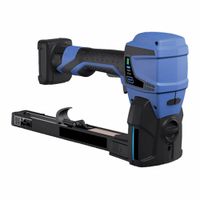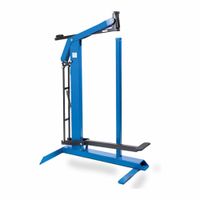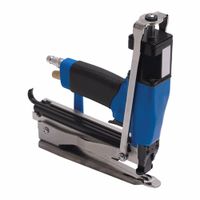Call +(254) 703 030 000 / 751 483 999 / 721 704 777
- Home
- Packaging Shipping
- Carton Staples Staplers
- Carton Plier Staplers
- Carton Staplers
.....Read More
Frequently Asked Questions
What is a carton stapler used for?
A carton stapler is a specialized tool used for sealing and securing corrugated cardboard boxes, commonly referred to as cartons. It is an essential device in packaging and shipping industries, where it ensures that boxes are securely closed to protect their contents during transit and storage. Carton staplers are particularly useful for heavy-duty applications where adhesive tapes might not provide sufficient strength or durability.
There are two main types of carton staplers: manual and pneumatic. Manual carton staplers are hand-operated and suitable for low to medium volume packaging tasks. They are portable and do not require a power source, making them ideal for smaller operations or areas without access to electricity. Pneumatic carton staplers, on the other hand, are powered by compressed air and are designed for high-volume packaging environments. They offer greater speed and efficiency, reducing operator fatigue and increasing productivity.
Carton staplers use staples made of metal, typically steel, which penetrate the flaps of the carton and bend inward to hold them together. This method provides a strong and tamper-evident seal, which is crucial for maintaining the integrity of the package. The staples are available in various sizes and gauges to accommodate different thicknesses and types of cardboard.
In addition to sealing boxes, carton staplers can also be used for reinforcing weak points in a carton, such as corners or edges, to prevent damage during handling. They are versatile tools that can be adjusted to accommodate different box sizes and closure styles, making them indispensable in industries like manufacturing, warehousing, and distribution.
How do you use a carton stapler?
To use a carton stapler, follow these steps:
1. **Preparation**: Ensure you have the correct staples for your carton stapler. Check the size and type recommended by the manufacturer.
2. **Loading Staples**: Open the stapler by releasing the latch or button, usually located at the back or side. Insert the staples into the magazine, ensuring they are aligned properly. Close the stapler securely.
3. **Positioning the Carton**: Place the carton on a stable surface. Ensure the flaps are aligned and the edges meet correctly for a neat seal.
4. **Adjusting Settings**: If your stapler has adjustable settings for staple depth or pressure, set them according to the thickness of the carton material.
5. **Stapling Technique**: Hold the stapler firmly with both hands. Position the stapler over the area where the flaps meet. For manual staplers, apply downward pressure to drive the staple through the carton. For pneumatic or electric staplers, press the trigger or button to activate.
6. **Staple Placement**: Start at one end of the carton and work your way to the other. Place staples at regular intervals, typically 2-3 inches apart, to ensure a secure seal.
7. **Checking the Seal**: After stapling, inspect the carton to ensure all staples are properly seated and the flaps are securely fastened. Adjust any misaligned staples if necessary.
8. **Safety Precautions**: Always wear safety goggles to protect your eyes from flying staples. Keep fingers clear of the stapling area to avoid injury.
9. **Maintenance**: Regularly clean and oil the stapler to ensure smooth operation. Replace worn parts as needed to maintain efficiency.
By following these steps, you can effectively use a carton stapler to secure packages for shipping or storage.
What are the different types of carton staplers?
Carton staplers are essential tools for sealing and securing boxes in various industries. They come in several types, each designed for specific applications:
1. **Manual Carton Staplers**: These are hand-operated and ideal for low-volume packaging needs. They are portable and require no power source, making them suitable for small businesses or occasional use.
2. **Pneumatic Carton Staplers**: Powered by compressed air, these staplers are designed for high-volume operations. They offer faster and more consistent stapling compared to manual versions, making them ideal for large warehouses and production lines.
3. **Electric Carton Staplers**: These use electricity to drive staples and are suitable for medium to high-volume applications. They provide consistent power and speed, reducing operator fatigue and increasing efficiency.
4. **Plier Carton Staplers**: These are handheld and resemble pliers. They are used for stapling smaller boxes or for applications where precision is required. They are versatile and can be used for both carton sealing and other stapling tasks.
5. **Box Bottom Staplers**: Specifically designed for stapling the bottom of boxes, these staplers ensure a secure seal that can withstand heavy contents. They are available in manual, pneumatic, and electric versions.
6. **Top Carton Staplers**: Used for sealing the top flaps of boxes, these staplers are essential for final packaging stages. They are available in various power options to suit different production needs.
7. **Roll Staplers**: These use a roll of staples instead of individual strips, allowing for longer operation without reloading. They are efficient for high-volume environments.
Each type of carton stapler is designed to meet specific operational needs, balancing factors like volume, speed, and ease of use.
What is the difference between manual and pneumatic carton staplers?
Manual carton staplers and pneumatic carton staplers are both tools used for sealing and securing cartons, but they differ in their operation, efficiency, and application.
Manual carton staplers are hand-operated tools that require physical force to drive staples into the carton. They are typically lightweight, portable, and cost-effective, making them suitable for low-volume packaging tasks. Manual staplers are ideal for small businesses or operations where mobility and budget are priorities. However, they can be physically demanding and less efficient for high-volume tasks, as they require more time and effort per staple.
Pneumatic carton staplers, on the other hand, are powered by compressed air, which automates the stapling process. These staplers are faster and require less physical effort, making them suitable for high-volume packaging environments such as warehouses and manufacturing facilities. Pneumatic staplers provide consistent stapling pressure, resulting in uniform and secure seals. They are generally more expensive and require an air compressor, which adds to the initial setup cost and limits portability. However, their efficiency and speed can significantly increase productivity in large-scale operations.
In summary, the main differences lie in their operation (manual vs. air-powered), efficiency (slower vs. faster), and suitability for different scales of packaging tasks (low-volume vs. high-volume).
How do you choose the right carton stapler for your needs?
To choose the right carton stapler, consider the following factors:
1. **Type of Stapler**: Decide between manual, pneumatic, or electric staplers. Manual staplers are suitable for low-volume tasks, pneumatic for medium to high-volume, and electric for high-speed, continuous operations.
2. **Staple Size and Type**: Ensure the stapler accommodates the staple size and type required for your cartons. Common sizes include 1/2", 5/8", and 3/4". Choose between C or A type staples based on carton thickness and material.
3. **Carton Material and Thickness**: Assess the material and thickness of your cartons. Thicker or double-walled cartons may require more robust staplers and longer staples for secure closure.
4. **Volume and Frequency**: Determine the volume of cartons you need to staple. High-volume operations benefit from pneumatic or electric staplers for efficiency and reduced operator fatigue.
5. **Ergonomics and Ease of Use**: Consider the stapler's weight, handle design, and ease of loading staples. Ergonomic designs reduce strain and increase productivity.
6. **Durability and Build Quality**: Look for staplers made from durable materials like steel or aluminum to withstand frequent use and ensure longevity.
7. **Adjustability**: Some staplers offer adjustable depth and clinch settings, allowing for customization based on carton specifications.
8. **Cost and Budget**: Balance your budget with the features and durability required. While initial costs may be higher for pneumatic or electric models, they can offer long-term savings in labor and efficiency.
9. **Brand and Warranty**: Choose reputable brands known for quality and reliability. Check for warranties or service agreements for added assurance.
10. **Safety Features**: Ensure the stapler has safety features like trigger locks or guards to prevent accidental firing and ensure operator safety.
What are the benefits of using a battery-operated carton stapler?
A battery-operated carton stapler offers several benefits, enhancing efficiency and convenience in packaging operations. Firstly, it provides mobility and flexibility, as it is not tethered to a power source, allowing operators to move freely around the workspace or between different locations without the constraints of cords or hoses. This portability is particularly advantageous in large warehouses or distribution centers.
Secondly, battery-operated staplers are user-friendly and reduce operator fatigue. They are typically lightweight and ergonomically designed, making them easier to handle for extended periods. The absence of manual force required in traditional staplers minimizes strain on the user, promoting a safer and more comfortable working environment.
Thirdly, these staplers offer consistent and reliable performance. They deliver uniform stapling pressure, ensuring secure and professional sealing of cartons, which is crucial for maintaining the integrity of packaged goods during transit. The precision and consistency reduce the risk of product damage and returns, enhancing customer satisfaction.
Additionally, battery-operated staplers are time-efficient. They enable faster stapling compared to manual methods, increasing productivity and throughput in high-volume packaging operations. The quick reloading and minimal maintenance requirements further contribute to operational efficiency.
Moreover, advancements in battery technology have led to longer-lasting power sources, reducing downtime for recharging and ensuring continuous operation. Many models also feature quick-charge capabilities, allowing for rapid recharging during breaks.
Finally, these staplers are environmentally friendly, as they eliminate the need for compressed air systems, reducing energy consumption and associated costs. This eco-friendly aspect aligns with sustainable business practices, appealing to companies focused on reducing their carbon footprint.
In summary, battery-operated carton staplers enhance mobility, reduce operator fatigue, ensure consistent performance, increase productivity, and support sustainability, making them a valuable tool in modern packaging operations.
How do you maintain and troubleshoot a carton stapler?
To maintain and troubleshoot a carton stapler, follow these steps:
1. **Regular Cleaning**: Keep the stapler clean by removing dust, debris, and staple fragments. Use compressed air or a soft brush to clean the interior and exterior parts.
2. **Lubrication**: Apply a few drops of light machine oil to the moving parts, such as the driver blade and magazine, to ensure smooth operation. Avoid over-lubrication as it can attract dust.
3. **Inspect for Wear and Tear**: Regularly check for worn or damaged parts, such as the driver blade, springs, and anvil. Replace any worn components to prevent malfunction.
4. **Check Staple Quality**: Use high-quality staples that are compatible with your stapler model. Poor-quality staples can cause jams and misfires.
5. **Adjust Staple Depth**: Ensure the stapler is set to the correct staple depth for the thickness of the carton. Adjust the depth setting as needed to avoid incomplete stapling or damage to the carton.
6. **Troubleshooting Jams**: If a jam occurs, disconnect the stapler from the power source (if electric) and carefully remove the jammed staple using pliers. Check for any obstructions in the magazine or driver channel.
7. **Test Firing**: After maintenance or troubleshooting, test the stapler on scrap material to ensure it is functioning correctly before returning to regular use.
8. **User Manual Reference**: Consult the user manual for specific maintenance guidelines and troubleshooting tips tailored to your stapler model.
9. **Professional Servicing**: If problems persist, consider professional servicing to address complex issues or repairs beyond basic troubleshooting.
By following these steps, you can ensure the efficient operation and longevity of your carton stapler.




